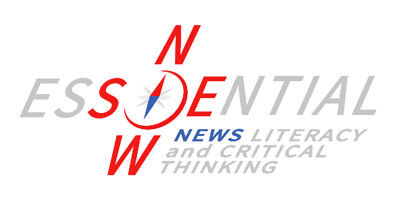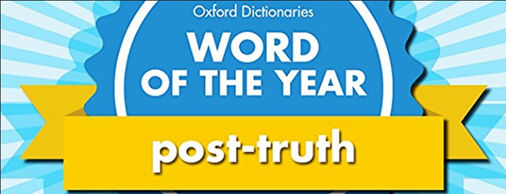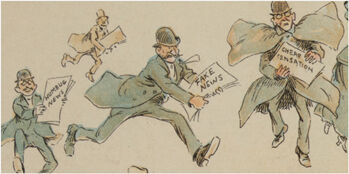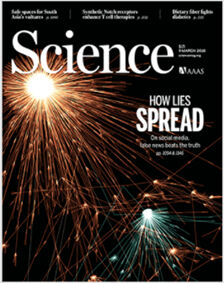Trainees Edition
Trainers Edition
Trainees Edition
Trainers Edition

Module 1: Post-Truth and Fake News
Module Description
The main purpose of this Module is to explain the notions of post-truth and fake news and how they threaten democracies and the well-being of societies and individuals.
A secondary aim is to guide trainers who want to use the content of this Module to train their trainees.
With these aims, the impact of the post-truth era in the information consumption of individuals along with guidelines about how to teach the subject are presented.
Trainees who successfully complete this Module will be able to:
- understand why fake news is a threat to democracies and the well-being of societies and individuals
- understand the post-truth notion
- define fake news
- understand how fast fake news spreads
- understand the connection between fake news and post-truth notions
- understand why fake news term is inadequate to describe the complexity of information pollution
Additionally, trainers who successfully complete this Module, will be able to demonstrate an understanding of how to teach the notions of post-truth and fake news and the threat they pose to democraties and well-being of people and societies.
Module Structure
This Module consists of the following parts:
- Objective, Description of the Content and Learning Outcomes
- Structure of the Module
- Guidelines for Trainees
- Guidelines for Trainers (how to get prepared, methods to use and tips for trainers)
- Content (study materials and exercises)
- Quiz
- Resources (references and recommended sources and videos)
Main objectives of the Module, description of the content and the learning outcomes are explained in the Module Description part. Guidelines for Trainees include instructions and suggestions for trainees. Guidelines for Trainers lead trainers through different phases of the training and provide tips which could be useful while teaching the subject. Content includes all study materials and the content related exercises. Quiz includes multiple choice and/or true/false questions for trainees to test their progress. Resources have two components: references and recommended sources for further reading and study. References is the list of sources cited in the content part. Recommended resources consist of a list of supplemental sources and videos which are highly recommended to read and watch for learning more on the topic.
Guidelines for Trainees
Trainees are expected to read the text, watch recommended videos and do the exercises. They can consult suggested resources for further information. After completing the study of the content, trainees are strongly suggested to take the quiz to evaluate their progress. They can revise the study material if needed.
Guidelines for Trainers
Guidelines for trainers include suggestions and tips for trainers on how to use the content of this Module to train people on the subject.
Getting Prepared
Preparing a presentation (PowerPoint/Prezi/Canva) which is enriched with visual materials (images and video clips) and research based factual information.
Getting Started
A short quiz (3 to 5 questions) in Kahoot or questions with Mentimeter can be used at the beginning for engaging participants in the topic. It can be used as a motivation tool as well as a tool to check trainees’ existing knowledge about the subject. Some examples for questions could be: What does post-truth mean? What is fake news?
Methods to Use
Various teaching methods can be used in combination during the training. Such as:
- Lecturing
- Discussion
- Group work
- Self reflection
Tips for Trainers
Warming-up
An effective way of involving participants and setting common expectations about what they will learn is to ask a few preliminary questions on the subject. This can be done through group work by asking trainees to discuss and collect ideas, but also individually by asking each participant to write their ideas on sticky notes.
The activity can be conducted as follows:
- Ask trainees whether they have ever come across the terms post-truth and fake news
- Invite trainees to elaborate on the connection of these two notions
- Ask trainees about the possible effect of fake news on democracy
Presenting the Objective of the Lesson
The objective of the lesson should be made clear (which is to explain the notions of post-truth and fake news, their connection as well their impact on democracies, individuals and societies). Following the warming-up questions it will be easier to clarify the objectives.
Presenting the Lesson Content
While presenting the content make sure to interact with the trainees and encourage them for active participation.
- Before providing a definition of post-truth and fake news, ask participants to come up with their own.
- When introducing the threats of post-truth and fake news, ask participants to elaborate on it first.
- When making the connection between post-truth and fake news, ask participants to elaborate on it first.
- Provide research findings when you reveal the dissemination speed of fake news.
- Ask participants for their opinion about why fake news spreads faster than the truth.
Concluding
Make a short summary of the lesson and ask a couple of questions which help underlying the most important messages you would like to give.
Following question can help:
- Ask trainees for the threats of post-truth politics, emotion based information consumption and fake news.
When concluding, make sure that trainees understand that in the post-truth era objective facts are less influential in shaping public opinion than emotion and personal belief and information consumption is mainly guided by people’s emotions, fake news spreads faster and reaches more people than the truth and the term fake news is inadequate to describe the complexity of information pollution.
Content: Post-Truth and Fake News
Introduction
A functioning democracy relies on educated and well-informed citizens. However, today, people are swamped with false information (Canales, 2020). The processes by which people get information and form their opinions and beliefs are therefore crucially important (Lewandowsky, Ecker, Seifers, Schwarz & Cook, 2012, p. 107). The media and the internet provide vast quantities of information, placing the onus on the individual to sort true from false. However, on one side sharing of false information, knowingly or not, has been on the rise (Canales, 2020), on the other hand, individuals have limited time, cognitive resources, or motivation to understand complex topics. As a result, misconceptions are commonplace. Moreover, once inaccurate beliefs are formed, they are remarkably difficult to eradicate (Ecker, Lewandowsky, Swire, & D. Chang, 2011, p. 570). The ramifications can be serious. If a majority believes in something that is factually incorrect, the mis/dis-information may form the basis for political and societal decisions (in areas as disparate as education, health, and the economy) that run counter to a society’s best interest; if individuals are misinformed, they may likewise make decisions for themselves and their families that are not in their best interest (Lewandowsky, Ecker, Seifers, Schwarz & Cook, 2012, p. 107).
Thus, mis/dis-information is seen as a serious threat to democracies (Filloux, 2017) and the well-being of both societies and individuals. Understanding why it is created in the first place, how it spreads as well as the structural reasons for its effectiveness is a necessity (Wardle & Derakhshan, 2017, p. 14) to fight against mis/dis-information.
In order to prevent people from being fooled by falsehoods, what is needed the most is training them to develop their critical thinking and news literacy skills.
Post-Truth
It is now said that we live in a post-truth era. Post-truth is defined as an adjective “relating to or denoting circumstances in which objective facts are less influential in shaping public opinion than appeals to emotion and personal belief” (Post-truth, 2021). The “post” prefix here refers to the irrelevance of the “truth” notion.
In the post truth era, information consumption is mainly guided by people’s emotions. In this era, people “increasingly believe information that appeals to their emotions and their personal beliefs, as opposed to seeking and accepting information that is regarded as factual and objective” (Cooke, 2018).
“Post-truth” has been announced as the word of the year in 2016 by Oxford Dictionaries. Dictionary’s editors noted a big increase in the usage of the term in 2016 compared to the previous year. The reason for the sudden spike in usage was mainly politics. It was largely due to the huge number of false news stories generated during the Brexit referendum in the United Kingdom and the presidential election campaigns in the United States (Flood, 2016). The term became popular in the form of post-truth politics and started to appear more frequently in the news since then.

"2016 Word of the Year: Post-Truth" by Mike Licht, NotionsCapital.com is licensed under CC BY 2.0
The role emotions play in shaping mass political behaviour is well researched in political psychology (Jones, Hoffman & Young, 2012, p. 1132). Findings of these research have proven that feelings are strong predictors for the preferences on political issues and candidates (Brader, 2005, p. 389). Most voting models are built on what voters remember and that recall of memory is highly biassed. Voters are more likely to remember information that generates affective reaction (Civettini & Redlawsk, 2009, p. 125). Politicians have been well aware of this and increasingly appeal to the emotions of citizens rather than reason. Critics denounce that this is manipulative as well as poisonous to democratic decision making (Brader, 2005, p. 388).

"Blah, Blah, Blah" by outtacontext is licensed under CC BY-NC-ND 2.0
Post-truth politics thrived in a polarised environment, where “the idea of truth is already split into notions of my truth vs. your truth”. Fake news further sharpens polarisation, causes corruption and damages “the fabric of democracy” (Al-Rodhan, 2017). In other words, existing political and social polarizations are reinforced by fake news. “Group polarization is an important phenomenon in social psychology and is observable in many social context” (e.g. feminism, vaccination, futbol, climate change, animal rigths, abortion, politics) (Group polarization, 2020). Today, the Internet and social media presented a new platform for fake news and group polarisation.
Fake News
In the post truth era, “people’s information consumption is being increasingly guided by the affective, or emotional dimension of their psyche, as opposed to the cognitive dimension. This post-truth reality is one of the reasons why fake news has become so inescapable, and consequently, why it’s so hard to combat and interrupt the production and dissemination of deliberately false information” (Cooke, 2018).
World history is full of examples of fabricated content (lies, rumours, propaganda) which was used to mislead people (Wardle, 2020). Although it has a long history, the term “fake news” has only recently become a buzzword. It is defined “to be news articles that are intentionally and verifiably false, and could mislead readers” (Allcott & Gentzkow, 2017, p. 213).
In a study on academic articles that used the term “fake news” between 2003 and 2017 it is noted that the term has been used to describe a number of different phenomena and related to distinct types of content from news satire, news parody, fabrication to manipulation, advertising and propaganda (Tandoc, Lim & Ling, 2018).

"fake-news-detail-2" by The Public Domain Review is marked with CC PDM 1.0
No matter in what form and with which label it comes with (such as urban myths, hoaxes, conspiracy theories, news satire and alternative facts), proliferation of ambiguous information today is at an alarming rate. The importance of combating fake news is underlined in the literature as well as in The Global Risks Report 2021 (The World Economic Forum, 2021) which addresses the challenges which demand immediate collective action.
Although the term fake news is not new at all, what’s new now is the ease with which anyone can create false and misleading content, and the speed with which that content can travel around the world (Wardle, 2020).
A research conducted by MIT scholars helps us better understand how fast false news spreads. Researchers have created a dataset, which includes over 100.000 news tweeted on Twitter, and classified this news as true or false based on the information available from fact-checking platforms. Investigation on differential diffusion of news stories in the dataset indicated that false news reached more people (70 percent more) and diffused faster (six times) than the truth. Researchers noted that “false news was more novel than true news, which suggests that people were more likely to share novel information” (Vosoughi, Roy & Aral, 2018).

Source: Science
Another analysis shows how viral fake election news stories outperformed real news on Facebook in 2016 in the US. It is found that top fake election news stories generated more (about 15 percent) total engagement (shares, reactions, and comments) on Facebook than top election stories from major news outlets (Silverman, 2016).
Fake news goes viral generally without being verified (Cooke, 2018). While propagandists, profiteers and trolls are responsible for the initial sharing of much of the misleading information found on social media, actions of the general public do play a role in the spread of false information (Vosoughi, Roy, & Aral, 2018, p. 1146). Thus, one way to reduce the spread of false information is to reduce the likelihood of individuals sharing that information (Fazio, 2020). What is worrying the most is that even if the false information is eventually disproved, the damage is done and it continues to be virtually available for future discovery (Cooke, 2018).
As Wardle (2019, p. 6) points out the information ecosystem is now dangerously polluted and is dividing rather than connecting people. Information pollution contaminates public discourse not only on political issues but also on a wide range of other (i.e., economic, societal and health related) issues. Medical misinformation, for instance, has always posed a threat to health (Wardle & Derakhshan, 2017, p.10). Such that, the term Infodemic, which is a blend of "information" and "epidemic" that typically refers to a rapid and far-reaching spread of information (Infodemic, 2021) is re-defined by the World Health Organization (2020) to address too much information (including false or misleading) during a disease outbreak which causes confusion and risk-taking behaviours that can harm health. Furthermore, a study on climate-related conspiracy theories found that public misconceptions about climate change can lead to lowered acceptance of the reality of climate change and lowered support for mitigation policies (Cook, Lewandowsky & Ecker, 2017).
There is an agreement in the related literature that a better alternative is needed to replace the term fake news. Because it is inadequate to describe the complexity of information pollution and fails to cover all different types of misleading content which is sometimes genuine however reframed in a new way. Thus, the use of more appropriate terms which help to make a distinction, is suggested (Wardle, 2019, p. 6; Wardle, 2020). This will be discussed in the next module.
Exercise
Quiz
References
Allcott, H. & Gentzkow, M. (2017). Social media and fake news in the 2016 election. Journal of Economic Perspectives, 31(2), 211–236. doi:10.1257/jep.31.2.211.
Al-Rodhan, N. (2017). Post-truth politics, the fifth estate and the securitization of fake news. Global Policy.
Brader, T. (2005). Striking a Responsive Chord: How Political Ads Motivate and Persuade Voters by Appealing to Emotions. American Journal of Political Science, 49(2), 388-405. doi:10.2307/3647684
Canales, S. B. (2020). The Australian Libraries and Information Association and National Archives Band Together Against Disinformation. The Canberra Times.
Civettini, A., & Redlawsk, D. (2009). Voters, Emotions, and Memory. Political Psychology, 30(1), 125-151.
Cook, J., Lewandowsky, S. & Ecker, U.K.H. (2017). Neutralizing misinformation through inoculation: Exposing misleading argumentation techniques reduces their influence. PLOS ONE 12(5): e0175799.
Cooke, N. (2018). Fake news and alternative facts: Information literacy in a post-truth era. ALA.
Ecker, U., Lewandowsky, S., Swire, B., & Chang, D. (2011). Correcting false information in memory: Manipulating the strength of misinformation encoding and its retraction. Psychonomic Bulletin & Review, 18, 570–578.
Fazio, L. (2020). Pausing to consider why a headline is true or false can help reduce the sharing of false news. Harvard Kennedy School Misinformation Review. 10.37016/mr-2020-009.
Filloux, F. (2017). You can’t sell news for what it costs to make. The Walkley Magazine on Medium.
Flood, A. (2016). 'Post-truth' named word of the year by Oxford Dictionaries. The Guardian.
Group polarization. (2020). In Wikipedia.
Infodemic. (2021). Merriam-Webster Dictionary.
Jones, P. E., Hoffman, L. H. & Young, D. G. (2012). Online emotional appeals and political participation: The effect of candidates on mass behavior. New Media & Society, 15(7), 1132–1150.
Lewandowsky, S., Ecker, U.K.H., Seifers, C. M., Schwarz, N. & Cook, J. (2012). Misinformation and its correction: Continued influence and successful debiasing. Psychological Science in the Public Interest, 13 (3), 106–131.
Post-truth. (2021). Oxford English Dictionary.
Silverman, C. (2016) This analysis shows how viral fake election news stories outperformed real news on Facebook. Buzzfeed News, November 16, 2016.
Tandoc, E.C., Lim, Z.W. & Ling, R. (2018). Defining “fake news”. Digital Journalism, 6(2), 137-153. DOI: 10.1080/21670811.2017.1360143
The World Economic Forum. (2021). The Global Risks Report 2021: Insight Report (16th Edition).
The World Health Organization. (2020). Infodemic.
Vosoughi S., Roy D. & Aral, S. (2018). The spread of true and false news online. Science, 359 (6380),1146-1151
Wardle, C. & Derakhshan, H. (2017). Information disorder: Toward an interdisciplinary framework for research and policymaking. The Council of Europe.
Wardle, C. (2019). First Draft’s essential guide to understanding information disorder. First Draft.
Wardle, C. (2020). The Age of information disorder. In C. Silverman (Ed.). Verification Handbook for Disinformation and Media Manipulation, 3rd Ed. European Journalism Centre.
Recommended Sources
Cooke, N. (2018). Fake news and alternative facts: Information literacy in a post-truth era. ALA.
Tandoc, E.C., Lim, Z.W. & Ling, R. (2018). Defining “fake news”. Digital Journalism, 6(2), 137-153. DOI: 10.1080/21670811.2017.1360143
Vosoughi S., Roy D. & Aral, S. (2018). The spread of true and false news online. Science, 359 (6380),1146-1151
Recommended Videos
Cooke, N. A. (2017). Post truth: Fake news and a new era of information literacy.
Lewandowsky, S. (2019). “Post-truth” and “fake news”: What, why, and how do we respond?
Wardle, C. (2020). The need for emotional scepticism.